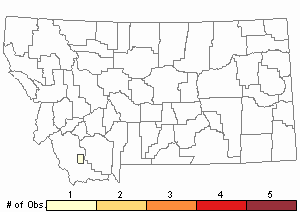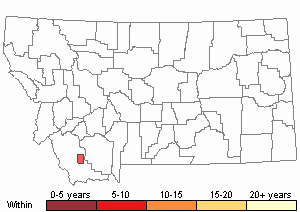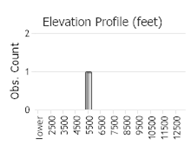View in other NatureServe Network Field Guides
NatureServe
Montana
Utah
Wyoming
Idaho
Wisconsin
British Columbia
South Carolina
Yukon
California
New York
Common Centaury - Centaurium erythraea
Non-native Species
Global Rank:
GNR
State Rank:
SNA
(see State Rank Reason below)
C-value:
1
Agency Status
USFWS:
USFS:
BLM:
External Links
State Rank Reason (see State Rank above)
Centaurium erythraea is a plant known from introducted from Europe into North America (Lesica et. Al. 2022). A conservation status rank is not applicable (SNA) because Centaurium erythraea is a non-native vascular plant in Montana that is not a suitable target for conservation activities.
General Description
PLANTS: Small, annual (sometimes biennial) forbs with fibrous roots and a single stem that can branch above the middle, 10 to 50 cm tall. Sources: Lesica et al. 2022; Pringle in Flora of North America [FNA] 2023.
LEAVES: Basal and cauline (stem) present. Basal leaves present during flowering and anthesis; blades elliptic to spatulate-obovate, 15-70 by 5-20 mm, apex rounded to subacute. Leaves arranged opposite on stem. Lower stem leaf blades elliptic to lanceolate and upper stem blades linear, in shape, 1-4 cm long. Sources: Lesica et al. 2022; Pringle in FNA 2023.
INFLORESCENCE: Dense, cymose (corymboid-like) with two lateral axes, producing yellowish to pink flowers – salverform in shape. Calyx: 5, linear, 4-6(7) mm long, and united at base. Corolla: 5 (sometimes 4), 10-17 mm long. Petal lobes are (3)4-6(8) Stamens: Exserted. Anthers twisted. Pistil: Single with 1 style and an ovate-elliptic stigma. Sources: Lesica et al. 2022; Pringle in FNA 2023.
TAXONOMY & NOMENCLATURE
The native North American species have been transferred from the genus Centaurium to Zeltnera - in the Flora of North America and Flora of the Pacific Northwest - 2nd Edition. The taxonomic shift is based on molecular phylogenetic studies (Mansion 2004; Mansion and Struwe 2004; Pringle in FNA 2023).
The revised treatments separate Centaurium and Zeltnera on the following morphology:
Centaurium
* Non-native species to North America
* Basal Leaves: rosette usually present during flowering
* Flowers: white to yellowish-pink
* Pistil with 2 stigmas crescent-shaped (elliptic to ovate to orbiculate) – as long as or longer than wide.
* Capsule cylindric
Zeltnera
* Native species to North America
* Basal Leaves: rosette absent by flowering
* Flowers: pink, rose-violet, or white.
* Pistil with 2 stigmas that are crescent to fan-shaped or 1 stigma with 2 fan-shaped lobes – as wide as or wider than long
* Capsule fusiform (ovoid to ellipsoid)
Centaurium comes from the Greek word kentauros meaning "centaur" which alludes to the plant’s supposed medicinal use by Chiron in Greek mythology (Pringle in FNA 2023).
Phenology
Across its range, flowering is summer to early fall (Pringle in FNA 2023).
Diagnostic Characteristics
Members of the Gentian Family (Gentianaceae) have opposite leaves, glabrous foliage, and flowers with 4 to 5 tubular petals of equal size. Traditionally, the genus
Centaurium is distinguished from other family members by a salverform flower – where lobes spread at right angles to the tube, a long and narrow corolla tube, and the of lack membranous tissue between the petals.
The
Manual of Montana Vascular Plants (Lesica et al. 2022) retains a traditional taxonomic treatment:
Common Centaury -
Centaurium erythraea, non-native
* Leaves: Small rosette of basal leaves present during flowering and anthesis
* Inflorescence: Densely branched, many flowers
* Seeds: Brown
Western Centaury -
Centaurium exaltatum, native, SOC
* Leaves: Basal rosette of basal leaves that wither by flowering time; thus, appearing all cauline
* Inflorescence: Little branched, few flowered
* Seeds: Dark reddish brown to nearly black
Species Range
Montana Range
Range Descriptions

 Non-native
Non-native
Range Comments
Common Centaury occurs from Vancouver Island to southern British Columbia in Canada to northern California in the United States (Giblin et al. [eds.] 2018). Primarily found in the west cascades, and occasionally is found eastward to south-central British Columbia, Idaho, eastern Oregon, and Montana (Giblin et al. [eds.] 2018).
Observations in Montana Natural Heritage Program Database
Number of Observations: 4
(Click on the following maps and charts to see full sized version)
Map Help and Descriptions
Relative Density

Recency



 (Observations spanning multiple months or years are excluded from time charts)
(Observations spanning multiple months or years are excluded from time charts)
Habitat
Across its range, Common Centaury grow in disturbed meadows, fields, roadsides, and other open habitats that are disturbed in the valleys of Montana (Lesica et al. 2022; Pringle in FNA 2023).
Reproductive Characteristics
Plants reproduce by seed.
FRUIT & GENETICS
The fruit is a capsule. Capsule is cylindric, 7-15 mm long. Seeds are. Seeds are diploid with a chromosome number of 2n = 40 (Europe) or 42 (Spain) (Pringle in FNA 2023).
Management
Stewardship Responsibility
References
- Additional ReferencesLegend:
 View Online Publication
View Online Publication
Do you know of a citation we're missing? Lesica, P., M.T. Lavin, and P.F. Stickney. 2012. Manual of Montana Vascular Plants. Fort Worth, TX: BRIT Press. viii + 771 p.
Lesica, P., M.T. Lavin, and P.F. Stickney. 2012. Manual of Montana Vascular Plants. Fort Worth, TX: BRIT Press. viii + 771 p. Lesica, P., M.T. Lavin, and P.F. Stickney. 2022. Manual of Montana Vascular Plants, Second Edition. Fort Worth, TX: BRIT Press. viii + 779 p.
Lesica, P., M.T. Lavin, and P.F. Stickney. 2022. Manual of Montana Vascular Plants, Second Edition. Fort Worth, TX: BRIT Press. viii + 779 p.
- Web Search Engines for Articles on "Common Centaury"





